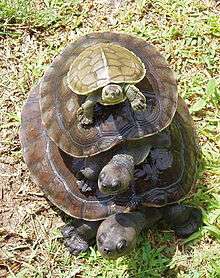Brahminy river turtle
| Brahminy river turtle | |
|---|---|
 | |
| Hardella thurjii | |
| Scientific classification | |
| Kingdom: | Animalia |
| Phylum: | Chordata |
| Class: | Reptilia |
| Order: | Testudines |
| Suborder: | Cryptodira |
| Family: | Geoemydidae |
| Genus: | Hardella Gray, 1870 |
| Species: | H. thurjii |
| Binomial name | |
| Hardella thurjii (Gray, 1831) | |
| Synonyms[1] | |
| |
The brahminy river turtle or crowned river turtle (Hardella thurjii) is a species of turtle found in northern India, Pakistan, and Bangladesh in the watersheds of the Ganges, Brahmaputra, and Indus rivers. It belongs to the monotypic genus, Hardella.
Description
This species has a shell with a large, moderately flat, dark brown or black carapace (dorsal surface) and a yellow or black plastron (ventral surface).[2] The shell is up to 18 inches (460 mm) in length in females, and is shorter in males.[3] The lower jaw is heavily dented.
Reproduction
The reproductive habits of H. thurjii are unique among reptiles in that the females lay their eggs under water rather than on dry land. Their reproductive cycle follows seasonal changes in the water levels of the rivers in which they live. In autumn, females lay their eggs under water, where higher water levels submerge the eggs for 40 to 45 days. In the winter, lower water levels expose the eggs for five months. The rising water levels of spring submerge the almost mature eggs once again, and the turtles hatch in the river.
Indian zoologist Dhruvajyoti Basu first documented the unique reproductive habits of the brahminy river turtle in 2011. The Prague Zoo incubated the first brahminy river turtle which was born in captivity in 2012.[4]
References
- ↑ Fritz Uwe; Peter Havaš (2007). "Checklist of Chelonians of the World" (PDF). Vertebrate Zoology. 57 (2): 223–224. ISSN 1864-5755. Archived from the original (PDF) on 2010-12-17. Retrieved 29 May 2012.
- ↑ Catalogue of the chelonians, rhynchocephalians, and crocodiles in the British Museum (Natural History), George Albert Boulenger, ASIN: B004QM945U, University of Toronto Libraries, 2001.
- ↑ Boulenger, G. A. 1890. Fauna of British India. Reptilia and Amphibia.
- ↑ "Screen Director: The largest turtle thriller.".
Notes
- Asian Turtle Trade Working Group (2000). "Hardella thurjii". IUCN Red List of Threatened Species. Version 2006. International Union for Conservation of Nature. Retrieved 11 May 2006. Listed as Vulnerable (VU A1cd+2 cd v2.3).
- Das, Indraneil 1984 Record length of the Brahminy River turtle Hardella thurjii Hamadryad 9 (3): 18.
External links
- Hardella thurjii at the Reptarium.cz Reptile Database
- http://itgmv1.fzk.de/www/itg/uetz/herp/photos/Hardella_thurjii_thurjii.jpg[]

